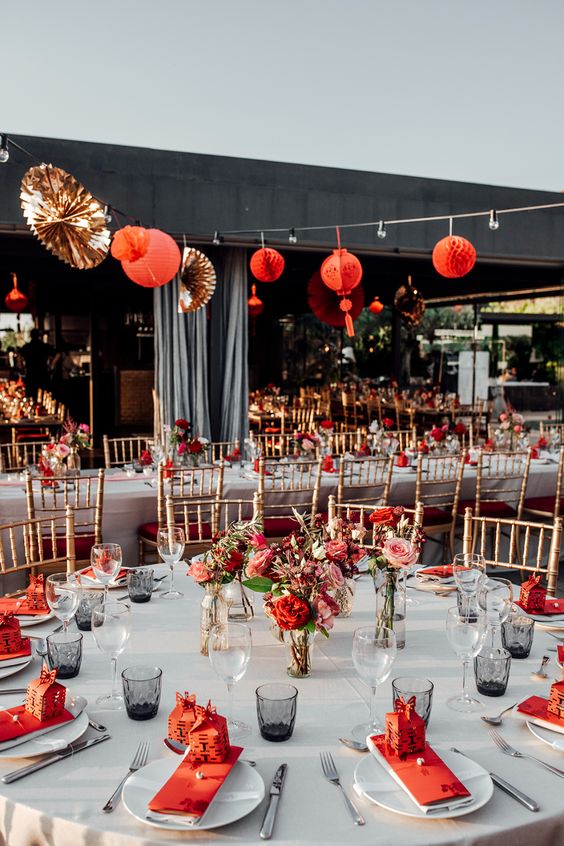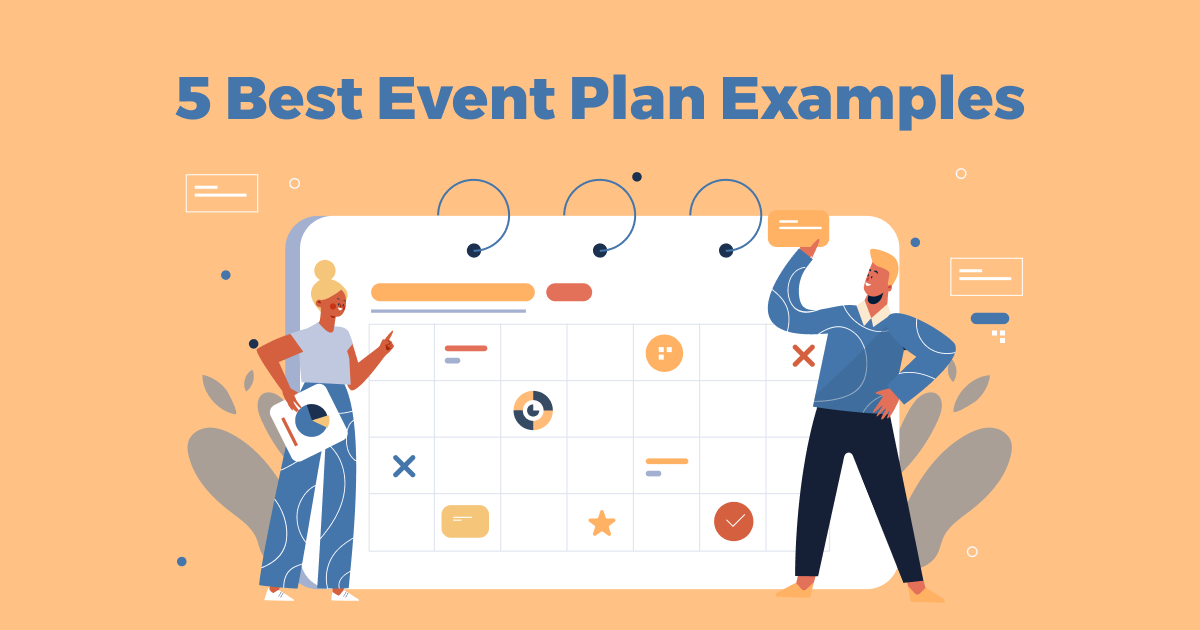What is an event plan? An event plan is a detailed strategy that carefully outlines everything needed to successfully organize a specific event. It’s like a step-by-step guide that helps keep things in order from start to finish. The main goal of event planning is to make sure all the activities go smoothly and that the event achieves its objectives. Whether it’s a wedding, a corporate meeting, a birthday party, or any special event, success depends on thorough preparation and creative thinking.
In this article, we’ll look at 5 popular event plan examples to give you useful insights and ideas to make your upcoming events and celebrations successful.
Exploring successful event planning is essential for creating memorable and impactful gatherings. Event plan examples below serve as practical illustrations of event planning in various contexts, offering insights and inspiration for those looking to craft their remarkable events.
Table of Contents
- Asian Wedding Event Plan Examples
- Birthday Party Event Plan Examples
- Fundraising Event Plan Examples
- Music Festival Event Plan Examples
- Online Event Plan Examples
- Bottom Line
- Frequently Asked Questions
Asian Wedding Event Plan Examples

Asian weddings are known for their rich traditions and cultural significance. In this section, we’ll provide a concise, six-step guide to help you create a memorable and culturally significant Asian wedding event.
- Step 1: Cultural Customs and Date Selection
Begin by understanding the cultural customs and traditions associated with your specific Asian heritage. This step will guide the choice of auspicious dates and essential ceremonies that reflect your cultural roots.
- Step 2: Budget and Guest List
Create a comprehensive budget that accommodates cultural aspects, such as traditional attire, rituals, and customs. Compile your guest list, including both families’ guests, and manage invitations for a prompt response.
- Step 3: Traditional Attire and Styling
Select traditional attire for the bride and groom that honors your cultural heritage. Coordinate outfits for the bridal party, and plan hair, makeup, and accessories to complement the cultural theme.
- Step 4: Rituals, Decor, and Vendors
Plan the specific cultural rituals and ceremonies that are significant to your Asian heritage. Work with vendors who are experienced in cultural weddings and align decorations with your cultural theme.
- Step 5: Ceremony, Reception, and Entertainment
Design a detailed schedule for the ceremony, reception, and entertainment, ensuring that cultural elements are seamlessly integrated into the program. Arrange traditional performances or music to enhance the cultural experience.
- Step 6: Rehearsal and Final Check
Conduct a rehearsal a few days before the wedding to ensure that all cultural rituals and customs are performed correctly. Make a final check to ensure everything is in place for a culturally significant and memorable Asian wedding.
Birthday Party Event Plan Examples
Birthday celebrations are a special time to rejoice in life’s milestones and create lasting memories. In this section, we’ll explore a concise, six-step guide to help you design an unforgettable birthday party that reflects the unique personality and interests of the celebrant.
- Step 1: Select a Party Theme and Age Group
Start by choosing a party theme that resonates with the birthday individual’s age and interests. Whether it’s a whimsical theme for children or an elegant one for adults, the theme provides the backdrop for the entire event.
- Step 2: Budgeting and Guest List
Establish a budget for the birthday celebration, covering expenses such as decorations, food, entertainment, and gifts. Create a guest list tailored to the event’s scale and the preferences of the guest of honor.
- Step 3: Venue Choice and Party Logistics
Pick an appropriate venue for the party, whether it’s at home, a park, a rented space, or a specialized venue that complements the chosen theme. Plan logistics like seating arrangements, catering, and activities to ensure a seamless and enjoyable event.
- Step 4: Invitations and Decor
Craft unique invitations in line with the chosen theme and send them out to guests. When it comes to decorations, consider using balloons, banners, and table settings that harmonize with the theme to create a festive ambiance.
- Step 5: Entertainment and Activities
Coordinate entertainment and activities suitable for the age group and preferences of the guests. These may include games, a live entertainer, a magician, or interactive activities, depending on the party’s style.
- Step 6: Cake and Party Mementos
Select or bake a birthday cake that complements the theme and is sure to delight the celebrant and guests. Consider party mementos or favor bags to express gratitude to attendees for being part of the celebration.
Fundraising Event Plan Examples
Fundraising events are a powerful way to gather support and resources for a worthy cause. In this section, we’ll present a six-step guide to help you plan a successful fundraising event that drives donations and creates a positive impact.
- Step 1: Define the Cause and Fundraising Goals
Start by clearly defining the cause you’re fundraising for and setting specific fundraising goals. Whether it’s for a charity, a non-profit organization, or a community project, understanding the cause and its financial needs is essential for planning.
- Step 2: Budgeting and Financial Planning
Create a budget that accounts for all event expenses, including venue rental, catering, marketing, and any additional costs. Determine how much of the funds raised will directly contribute to the cause.
- Step 3: Guest List and Donor Engagement
Compile a list of potential donors, sponsors, and supporters. Engage with them early, ensuring they understand the cause and the impact their contribution can make. Secure commitment and confirm their attendance.
- Step 4: Event Venue and Logistics
Choose an appropriate venue for the event that aligns with the cause and has the capacity to accommodate your guest list. Plan logistics, such as seating arrangements, audio-visual equipment, and displays that showcase the cause’s importance.
- Step 5: Fundraising Strategies and Appeals
Develop effective fundraising strategies, which may include live or silent auctions, donation stations, or pledge drives. Prepare impactful appeals and stories that convey the cause’s significance to inspire donations.
- Step 6: Post-Event Recognition and Impact Reporting
After the event, acknowledge and thank donors and sponsors. Provide a report detailing the event’s outcomes and the positive impact of their contributions. Keep donors informed about how their support is making a difference.
Music Festival Event Plan Examples
Music festivals are dynamic celebrations of rhythm, sound, and artistic expression. In this section, we’ll provide a concise guide, outlining six key steps to help you organize an engaging and unforgettable music festival that brings people together through the magic of music.
- Step 1: Define the Festival Vision and Theme
Commence by defining the festival’s vision and theme, ensuring it aligns with the chosen musical genre. Is it a rock festival, an electronic dance music extravaganza, or a world music fusion? The theme sets the stage for the entire festival experience.
- Step 2: Budgeting and Financial Planning
Establish a comprehensive budget that covers costs like artist fees, venue rentals, security, marketing, and logistical requirements. Diversify revenue streams through ticket sales, sponsorships, and merchandise to ensure the festival remains financially viable.
- Step 3: Lineup Curation and Artist Agreements
Assemble a lineup of artists and bands that resonate with the festival’s theme and target audience. Negotiate and confirm contracts with the performers, addressing their technical and hospitality requirements.
- Step 4: Venue Selection and Logistics
Select a venue that complements the festival’s ambiance and has the capacity to accommodate the expected audience. Plan logistical aspects, including stage configurations, sound and lighting equipment, and crowd control.
- Step 5: Ticketing Strategies and Promotion
Implement an efficient ticketing system and launch a comprehensive promotional campaign to create anticipation and attract festival-goers. Employ diverse marketing channels, from social media and music publications to collaborations with local businesses.
- Step 6: Safety Measures and Enhancing the Festival Experience
Prioritize safety by collaborating with local authorities, security teams, and medical services. Enhance the festival experience by offering a variety of food vendors, art installations, and engaging activities beyond the music.
Online Event Plan Examples
The pandemic has changed how we host events. The transformation from in-person events to virtual events is becoming more popular due to cost reduction, geographical unlimited, and flexible event schedule. Zoom and collaborative presentation tools like AhaSlides address the concerns of users in event management. This means that host and audience interaction, and audience and audience interaction are increased through games and quizzes. It is easy to create games and quizzes via AhaSlides, you can pick the available template and customize freely in minutes. Especially, when you want to host a Q&A session, in case not many participants are willing to speak out, using a live Q&A template with real-time updates can be a great conclusion.
Bottom Line
In the field of event planning, the art of creating unforgettable experiences spans a multitude of circumstances, each with its own characteristics and goals. Through exploring event planning examples in different settings, we discovered the blueprint for creating seamless and memorable gatherings.
Effective planning and execution are the keys to turning simple events into remarkable experiences. Whether you’re a seasoned event coordinator or starting a grand opening planning project, success will be achieved through attention to detail, creative vision, and diligent organization.
More tips and advice about events? Pick an event that you’re concerned with, and we’ll give you a helping hand!
Frequently Asked Questions
What are the 5 components of an event?
Objective
Audience
Venue and Logistics
Program and Content
Promotion and Marketing
What are the 7 stages of event planning?
Research and Conceptualization: This stage involves defining the event’s purpose and objectives, as well as understanding the target audience.
Planning: Detailed planning is essential, including budgeting, selecting the venue, coordinating logistics, and negotiating vendor contracts.
Design and Theme Development: In this stage, the aesthetic elements of the event are crafted, including decorations, thematic elements, and the overall look and feel.
Promotion and Marketing: A solid marketing strategy is developed to promote the event and attract attendees. This may involve advertising, social media campaigns, and other promotional efforts.
Execution: The event takes place during this stage, involving the coordination, setup, and management of all event components.
Monitoring and Control: This stage focuses on ensuring the smooth operation of the event, addressing any issues, and adapting to changes as necessary.
Post-Event Evaluation: After the event, it’s crucial to assess its success, gather feedback, and analyze what worked and what can be improved for future events.
What are event planning goals?
Event planning goals are the specific achievements and outcomes that event organizers aim to realize when planning and executing an event. These goals encompass factors like attendance, budget management, attendee satisfaction, the achievement of event objectives, effective marketing, logistical efficiency, feedback collection for improvement, networking, brand or cause visibility, and revenue generation. These goals provide a framework for measuring the success of an event and guide planners in ensuring the event’s objectives are met while delivering a positive and memorable experience for attendees.





